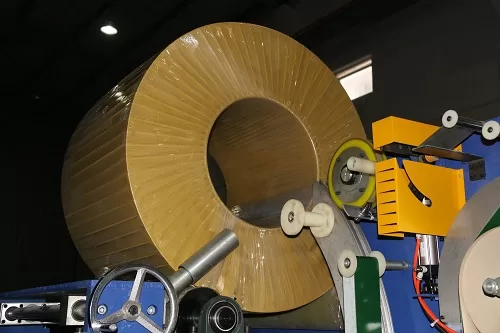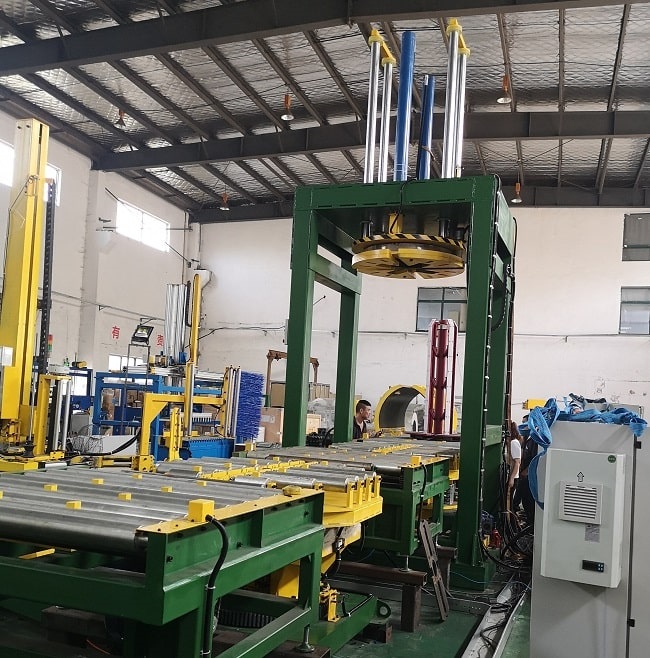Optimizing Wire Coil Handling: A Guide to Automatic Compacting and Strapping Systems
Efficient handling and packaging of wire coils are critical in industries ranging from construction to manufacturing. Loose or poorly packaged coils can lead to logistical challenges, wasted space, potential product damage, and safety hazards. Automatic wire coil compacting and strapping systems offer a robust solution, streamlining the packaging process and enhancing overall operational efficiency.
Understanding Automatic Wire Coil Compacting and Strapping
An automatic wire coil compacting and strapping system is an integrated piece of industrial equipment designed to:
- Compress: Reduce the volume of a wire coil by applying pressure, making it denser and more stable.
- Strap: Securely fasten the compressed coil using steel or plastic (PET/PP) straps, ensuring it maintains its form during handling, storage, and transport.
These systems typically consist of a feeding conveyor, a compression station, one or more strapping heads, a control panel (PLC), and an exit conveyor.
The Automated Process: Step-by-Step
While specific configurations vary, the general automated process follows these steps:
- Coil Loading: Wire coils are placed onto the infeed conveyor, often using a forklift, crane, or integrated handling equipment like specifically designed wire carriers or baskets. The type of carrier is crucial for seamless integration, especially with upstream processes like galvanizing lines.
- Transfer to Compactor: The coil moves automatically into the compression station.
- Compression: Hydraulic or mechanical pressure is applied to the coil, reducing its height and increasing its density. The required compressing force depends heavily on the wire type, coil size, and desired final package density.
- Strapping: Once compressed, strapping heads automatically apply, tension, seal, and cut the strapping material (steel or PET) at predetermined positions around the coil. The number and placement of straps are typically programmable.
- Discharge: The compacted and strapped coil is transferred to an outfeed conveyor or accumulation area, ready for warehousing or shipping.
- Optional Integrated Functions: Many systems can incorporate additional automated steps such as weighing, labeling, stretch wrapping, or stacking.
See an example of a wire coil compactor integrated with a strapping machine configuration here.
Key Considerations for Implementation
Selecting and implementing an automatic compacting and strapping system requires careful evaluation of several factors:
- Coil Specifications:
- Wire Type (e.g., steel, copper, aluminum)
- Coil Dimensions (ID, OD, height/width)
- Coil Weight
- Compression Requirements:
- Necessary Compressing Force (ensure adequate density without damaging the wire)
- Strapping Material:
- Steel Strapping: Offers high tensile strength, suitable for very heavy or high-tension coils. However, it can be more expensive and potentially abrasive.
- PET Strapping: Provides excellent retained tension, is resistant to rust and UV, often more cost-effective, and generally safer to handle. While strong, it may not be suitable for the most demanding high-tension applications where steel is traditionally preferred. Its resistance to damage during handling is a key factor.
- PP Strapping: Lighter duty, typically used for less demanding bundling applications.
- Throughput Needs: The system must match or exceed the production rate of the upstream process (e.g., wire drawing or rolling mill).
- Integration: Compatibility with existing production lines (like galvanizing or annealing lines) and material handling equipment (forklifts, cranes, AGVs, specialized wire carriers/baskets) is essential. Modifications to winding machines or handling procedures may be necessary.
- Automation Level: Systems range from semi-automatic to fully automatic, impacting labor requirements and initial investment.
- Safety Features: Ensure compliance with safety standards, including guarding, emergency stops, and interlocks.
- Maintenance: Consider ease of access for routine maintenance and availability of spare parts.

Benefits of Automated Wire Coil Packaging
Investing in automation for wire coil compacting and strapping yields significant advantages:
- Increased Efficiency: Faster cycle times compared to manual methods, boosting overall throughput.
- Improved Package Quality: Consistent compression and strap tension lead to uniform, stable coils.
- Enhanced Safety: Reduces manual handling risks associated with heavy coils and strapping tools.
- Space Optimization: Denser coils require less storage and transport space.
- Reduced Labor Costs: Frees up personnel for other value-added tasks.
- Material Savings: Precise strap application minimizes waste.
Visualizing the Process
Understanding how these machines operate can be aided by visual examples. Below are representations of typical automatic wire coil handling and packaging lines:
Example 1: Automatic Compacting and Strapping
(Caption: Video demonstrating a typical automatic wire coil compactor and strapping sequence.)
Example 2: Integrated Coil Handling and Packaging Line
(Caption: Video showcasing a more comprehensive automated line, potentially including coil transport, weighing, and wrapping in addition to compacting and strapping.)

Conclusion
Automatic wire coil compacting and strapping systems are vital tools for modern wire production and processing facilities. By carefully considering coil characteristics, production requirements, strapping options (like the trade-offs between robust steel and versatile PET), and integration needs, manufacturers can implement solutions that significantly improve efficiency, safety, and package quality. As automation technology continues to advance, these systems will play an increasingly important role in optimizing wire handling logistics.
For further information on packaging standards, consult resources from organizations like the ASTM International (specifically committees related to packaging) or investigate material handling best practices from sources like the Material Handling Industry (MHI). Considering solutions requires looking at the entire process flow, from winding onto compatible carriers to final dispatch, as exemplified by integrated system providers like those found at www.fhopepack.com.
